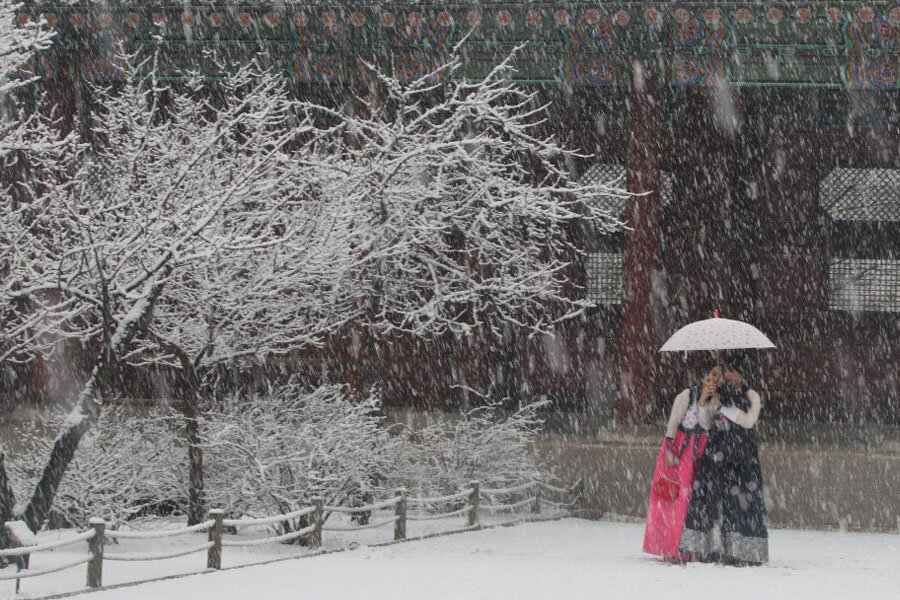South Korea struggles to overcome cultural stigma of AIDS
Loading...
| Seoul, South Korea
It did not take long for Lee Jong-nam to grasp how his caretakers viewed patients with HIV/AIDS.
When he arrived at the Sudong Yonsei Sanitarium in 2013, South Korea’s only long-term care center for HIV/AIDS patients, he handed nurses 100 pages of medical history, only to have it returned 30 minutes later with assurances it had been thoroughly reviewed.
Nights were often humiliating for Mr. Lee – whose diagnosis left him paralyzed on one side – as staff ignored his calls for assistance in relieving himself. Relatives had to provide vital medication, and verbal abuse was common.
Once home to dozens of patients, Sudong's designation as a long-term care facility for HIV/AIDS patients was revoked in December 2013. Lee, which isn’t his real name, left five months later.
The center’s tarnished past has made it a poignant symbol of the fear and disdain that HIV/AIDS patients often evoke in South Korea. Many risk being ostracized by family and friends, saddled with a stigma that has its roots in Confucian beliefs that still thrive alongside the country’s advanced economy and pop culture juggernaut.
Kim Jae-cheon, an HIV/AIDS activist, says that many Koreans believe people with the illness are simply bad and that they bring shame upon their community. In a society dominated by conservative views of sex, HIV/AIDS is also often associated with the LGBT community and prostitutes, both of which are viewed negatively here.
“Once they find out their [child] is infected with HIV, then they will ignore it,” says Mr. Kim. “Sometimes they don’t collect their body when they die.”
While still uncommon, HIV has become markedly more prevalent in South Korea since its first case in 1985. The country recorded 1,280 cases between 1985 and 2000. Over the past 16 years, that number has jumped to more than 13,000.
A lasting stigma
The government’s decision to revoke Sudong’s designation followed a flood of reports of negligence and abuse at the center, including the alleged rape of one patient and early death of another.
But more than two years later, the patients’ fates remain precarious. A number of them remain at Sudong. The rest are scattered among non-medical facilities that activists say are ill-equipped to provide adequate care.
Nanuri Plus, an HIV/AIDS advocacy group, has documented more than two dozen health facilities that have refused to admit former Sudong patients for fear of spreading the virus.
“Even medical personnel are afraid of people living with HIV,” says Kim, who works for the group. “They are afraid of being infected.”
Nanuri reports that three patients who were previously at Sudong have died since the center was downgraded, including one from suicide. In 2005, a study by the National Human Rights Commission of Korea found that HIV/AIDS sufferers are 10 times more likely to commit suicide than the average Korean. The country has one of the highest suicide rates in the world.
The government says it is illegal for health care providers to refuse treatment to HIV/AIDS patients, but so far it has appeared unwilling to intervene more forcefully. Authorities have yet to punish anyone for mistreatment or denial of care.
“In our opinion, the legal punishment should be handled by the court,” the Ministry of Health said in statement, while noting that the National Human Rights Commission had found “nothing significant to report” in its investigation.
The ministry introduced new subsidies for the long-term care of low-income HIV/AIDS patients in January. But Son Moon-soon, the president of Korean Network of People Living with HIV/AIDS, says the government has “no will” to act, pointing to other funding cuts.
“Hospitals not receiving people is a problem,” he says, “but the government itself has no determination about AIDS. It thinks we should be thankful that it gives out medication."
Life after Sudong
Today, the health and even location of many of the more than 50 original patients from Sudong remain unclear. Advocates charge that the center has denied them access to monitor their wellbeing.
Nonetheless, both advocates and the government agree that some patients remain at the maligned facility and that others now reside at non-medical facilities, such as shelters run by religious charities.
Ben Wagner, a longtime human rights activist in South Korea, says he plans to file an emergency complaint about the neglect of Sudong's former patients to the United Nations Human Rights Committee. He says their treatment amounts to a serious human rights violation.
"The loss of life and continued suffering since 2014 is evidence of that," Mr. Wagner says.
Since leaving Sudong, Lee has recovered from his paralysis. He receives treatment at another hospital and lives alone in Seoul. He found work at non-profit organization that helps the poor. Apart from his younger sister, he hasn’t told anyone in his family about his diagnosis.
“My mother is more than 80 years old,” he says. “If she heard about this, I’m worried she wouldn’t know what to do.”







